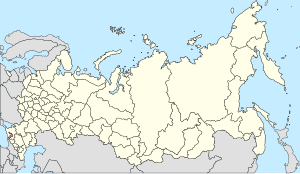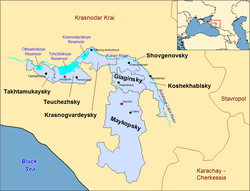The Republic of Adygea (English pronunciation: /ɑːdɨˈɡeɪ.ə/;[13] Russian: Респу́блика Адыге́я, tr. Respublika Adygeya, IPA: [ɐdɨˈgʲejə]; Adyghe: Адыгэ Республик, Adǝgă Respublik) is a federal subject of Russia (a republic) enclaved within Krasnodar Krai. Its area is 7,600 square kilometres (2,934 sq mi) with a population of 440,400 (preliminary 2010 Census results).[6] Its capital is Maykop.
Contents[hide] |
[edit] Geography
Adygea lies in south-east Europe in the north foothills of the Caucasus Mountains, with plains in the north, and mountains in the south. Forests cover almost 40% of its territory.
- Area: 7,600 square kilometres (2,934 sq mi)
- Borders: Adygea is entirely surrounded by Krasnodar Krai
- Highest point: Chugush Mountain 3,238 metres (10,623 ft)
[edit] Rivers
The 870 kilometres (541 mi) long Kuban River is one of the major navigable rivers in the Caucasus region. It forms part of the northern border between Adygea and Krasnodar Krai. Other rivers include:
- Belaya River
- Chokhrak River
- Dakh River
- Fars River
- Khodz River
- Kisha River
- Bolshaya Laba River (forming part of the eastern border between Adygea and Krasnodar Krai)
- Psekups River
- Pshish River
- Sakhray River
- Sukhoy Kurdzhips River, which flows near the archaeological site at Mezmaiskaya cave[14]
[edit] Lakes
There are no large lakes in the republic. There are, however, several large reservoirs, including:
[edit] Mountains
The republic's major mountains range in height from 2,000 to 3,238 m and include:
- Chugush Mountain 3,238 metres (10,623 ft)
- Mount Fisht 2,868 metres (9,409 ft)
- Oshten Mountain
- Pseashkho Mountain
- Shepsi Mountain
[edit] Natural resources
The republic is rich in oil and natural gas. Other natural resources include gold, silver, tungsten, and iron.
[edit] Climate
- Average January temperature: −0.5 °C (31.1 °F)
- Average July temperature: +23 °C (73.4 °F)
- Average annual precipitation: 70 centimeters (27.6 in)
[edit] History
The Adyghe people, sometimes known as Circassians, were the ancient dwellers of the North-West Caucasus since the 13th century.
Cherkess (Adyghe) Autonomous Oblast was established within the Russian SFSR on July 27, 1922, on the territories of Kuban-Black Sea Oblast, primarily settled by the Adyghe people. At that time, Krasnodar was the administrative center. It was renamed Adyghe (Cherkess) Autonomous Oblast on August 24, 1922, soon after its creation. In the first two years of its existence the autonomous oblast was a part of the Russian SFSR, but on October 17, 1924, it was transferred to the jurisdiction of the newly created North Caucasus Krai within the RSFSR.[15]
It was renamed Adyghe Autonomous Oblast (AO) in July 1928. On January 10, 1934, the autonomous oblast became part of new Azov-Black Sea Krai, which was removed from North Caucasus Krai. Maykop was made the administrative center of the autonomous oblast in 1936. Adyghe AO became part of Krasnodar Krai when it was established on September 13, 1937.
On July 3, 1991, the oblast was elevated to the status of a republic under the jurisdiction of the Russian Federation. The first President of the republic was Aslan Aliyevich Dzharimov, elected in January 1992. From 2002 to 2007, Hazret Sovmen was President. He, and most of the rest of the political elite in Adygea, are Adyghes. As a reaction to that, an organization calling itself the Union of Slavs was established, claiming that ethnic Russians are discriminated against in Adygea. They advocate the merger of Adygea with Krasnodar Krai, but have so far have had little support for that proposition from the Russian government.
[edit] Politics
The head of the government in Adygea is the Head (called "President" until May 2011), who is appointed for a five-year term. Proficiency in the Adyghe language is a prerequisite for the candidate.[16]
The current Head, Aslan Tkhakushinov (since January 13, 2007), succeeded Hazret Sovmen, appointed by Vladimir Putin, although he received only 2% of the vote in 2002.[17] There is also a directly elected State Council (Khase or Xase—not to be confused with the Adyghe Khase, a union of Adyghe who supported Sovmen for a second term), which comprises the Council of Representatives and the Council of the Republic. Both councils are elected every five years and have 27 deputies each.
The republic sends three representatives to the parliament of the Russian Federation; one to the State Duma and the other two to the Federation Council.
The Constitution of the Republic of Adygea was adopted on May 14, 1995.
[edit] Divisions
The Republic of Adygea is administratively divided into seven districts (raions), two cities/towns, and five urban-type settlements. Municipally, the republic is divided into two urban okrugs, five urban settlements, and 46 rural settlements.
[edit] Demographics
- Population: 447,109 (2002)
- Urban: 234,900 (52.5%)
- Rural: 212,209 (47.5%)
- Male: 208,019 (46.5%)
- Female: 239,090 (53.5%)
- Females per 1000 males: 1,149
- Average age: 37 years
- Urban: 36.6 years
- Rural: 37.4 years
- Male: 34 years
- Female: 39.6 years
- Number of households: 151,597 (with 440,449 people)
- Urban: 82,949 (with 230,286 people)
- Rural: 68,648 (with 210,163 people)
[edit] Vital statistics
- Source:[18]
| Births | Deaths | Birth rate | Death rate | |
|---|---|---|---|---|
| 1970 | 5,681 | 3,307 | 14.7 | 8.6 |
| 1975 | 5,900 | 3,907 | 14.9 | 9.9 |
| 1980 | 6,610 | 4,828 | 16.2 | 11.8 |
| 1985 | 6,966 | 5,283 | 16.5 | 12.5 |
| 1990 | 6,171 | 5,375 | 14.2 | 12.3 |
| 1991 | 5,912 | 5,905 | 13.5 | 13.5 |
| 1992 | 5,306 | 5,969 | 12.0 | 13.5 |
| 1993 | 4,774 | 6,662 | 10.7 | 14.9 |
| 1994 | 4,907 | 6,519 | 10.9 | 14.5 |
| 1995 | 4,798 | 6,475 | 10.7 | 14.4 |
| 1996 | 4,625 | 6,382 | 10.3 | 14.2 |
| 1997 | 4,430 | 6,302 | 9.8 | 14.0 |
| 1998 | 4,340 | 6,245 | 9.6 | 13.9 |
| 1999 | 3,879 | 6,215 | 8.6 | 13.8 |
| 2000 | 4,071 | 6,710 | 9.1 | 15.0 |
| 2001 | 4,212 | 6,566 | 9.4 | 14.7 |
| 2002 | 4,540 | 6,715 | 10.2 | 15.0 |
| 2003 | 4,634 | 6,929 | 10.4 | 15.5 |
| 2004 | 4,648 | 6,645 | 10.4 | 14.9 |
| 2005 | 4,550 | 6,726 | 10.3 | 15.2 |
| 2006 | 4,606 | 6,686 | 10.4 | 15.1 |
| 2007 | 5,210 | 6,454 | 11.8 | 14.6 |
| 2008 | 5,601 | 6,558 | 12.7 | 14.8 |
[edit] Ethnic groups
- According to the 2002 Census,[7] ethnic Russians make up 64.5% of the republic's total population, while the ethnic Adyghe are only 24.2%. Other groups include Armenians (3.4%), Ukrainians (2.0%), Kurds (3,631, or 0.8%), Tatars (2,904, or 0.7%), and a host of smaller groups, each less than 0.5% of the population.
| 1926 census | 1939 census | 1959 census | 1970 census | 1979 census | 1989 census | 2002 census | |
|---|---|---|---|---|---|---|---|
| Adyghe | 50,821 (44.8%) | 55,048 (22.8%) | 65,908 (23.2%) | 81,478 (21.1%) | 86,388 (21.4%) | 95,439 (22.1%) | 108,115 (24.2%) |
| Russians | 29,102 (25.6%) | 171,960 (71.1%) | 200,492 (70.4%) | 276,537 (71.7%) | 285,626 (70.6%) | 293,640 (68.0%) | 288,280 (64.5%) |
| Armenians | 738 (0.7%) | 2,348 (1.0%) | 3,013 (1.1%) | 5,217 (1.4%) | 6,359 (1.6%) | 10,460 (2.4%) | 15,268 (3.4%) |
| Ukrainians | 26,405 (23.3%) | 6,130 (2.5%) | 7,988 (2.8%) | 11,214 (2.9%) | 12,078 (3.0%) | 13,755 (3.2%) | 9,091 (2.0%) |
| Others | 6,415 (5.7%) | 6,313 (2.6%) | 7,289 (2.6%) | 11,198 (2.9%) | 13,939 (3.4%) | 18,752 (4.3%) | 26,355 (5.9%) |
[edit] Economy
Even though it is now one of the poorest parts of Russia, the republic has abundant forests and rich soil. The region is famous for producing grain, sunflowers, tea, tobacco, and other produce. Hog and sheep breeding are also developed.
Food, timber, woodworking, pulp and paper, heavy engineering, and metal-working are the most developed industries.
[edit] Transportation
There is a small airport in Maykop (ICAO airport code URKM). Several rail lines pass through the republic.
[edit] Culture
The Adyghe language (Adyghabze) is a member of the Northwest Caucasian group of Caucasian languages. Along with Russian, Adyghe is the official language of the republic.
There are 8 state and 23 public museums in the republic. The largest museum is the National Museum of the Republic of Adygea in Maykop.
[edit] Education
Adyghe State University and Maykop State Technological University, both in the capital Maykop, are the two major higher education facilities in Adygea.
[edit] Religion
The greater majority of the Republic of Adygea are adherents to Orthodoxy, with an estimated 70% of the population being Orthodox Christians.
25% of the Republic's population are adherents of Islam
Ethnically, most of the Adygeans are Sunni Muslims.








No comments:
Post a Comment